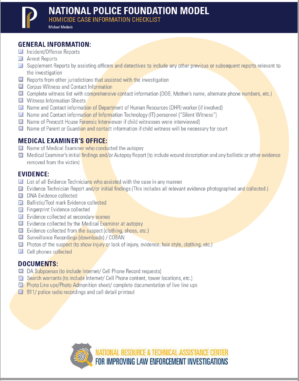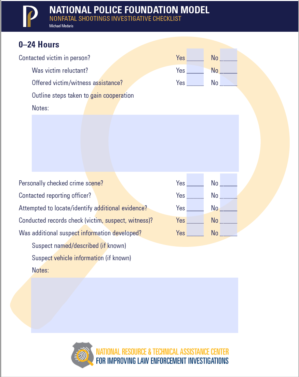Tools for Investigators
Homicide Case Information Checklist
The following checklist was created by Michael Medaris and is designed as a general outline of what the District Attorney’s Office will be requesting at charging or shortly thereafter. It is by no means exhaustive. Every case presents its own unique set of circumstances and many cases call for ‘thinking outside of the box(es)’ that are presented below. However, below is a good starting point for a detective to consider during the investigation of his/her case.
Defining and Collecting Data About Nonfatal Shootings: A Checklist
The following checklist was created by Beth Huebner and Natalie Hipple and is designed to help your agency work through how to define a nonfatal shooting and to collect ample data on these events. A clear definition of a nonfatal shooting has been provided and will allow for consistent measurement and reporting. Agencies may want to alter their data collection methodologies based on local data availability and local norms. For further information, please reference A Nonfatal Shooting Primer by Beth Huebner and Natalie Hipple.
Nonfatal Shootings Investigative Checklist
The following checklist was created by Michael Medaris. This investigative checklist is not all-encompassing and serves only as a guide to remind investigators of the myriad steps related to the complex and varied processes of criminal investigations. This checklist can be referred to at any stage during the investigative process, especially after the case has been inactive for a period of time with no significant progress being made. It is recommended that a group of personnel who are familiar with the case be involved in discussing the items on the checklist as they relate to their specific case. This serves to bring a broader body of experience and perspective to the analysis and discussion of how to proceed with the investigation.
NIBIN Lead Investigative Checklist
The following checklist was developed by Michael Eberhardt and is designed for investigators assigned to gun crime related events. Crime Gun Intelligence Centers (CGICs) provide ongoing support to criminal investigations. Once a possible match, or "lead" is identified the crime lab sends information on the lead/hit to investigators. A NIBIN lead report has many potential tactical and strategic uses for law enforcement. Law enforcement investigators can use it to link crimes, which can help to identify suspects. They can also use it to understand patterns of gun crime, such as gun sharing and trafficking. The CGIC can add value to investigative information as it develops, giving investigators every possible advantage to solve cases. The following checklist details next steps for investigators and detectives once a NIBIN lead is received.
Homicide Publications
- Supporting a Safer Community in Charlotte: Secondary Victims and the Beginning of Homicide Support Groups, COPS Office
- Supporting a Safer Community in Richmond: Secondary Victims and the Beginning of Homicide Support Groups, COPS Office
- Clearing Homicides: Role of Organizational, Case, and Investigative Dimensions (PDF)
- Organizing for Effective Homicide Investigations (PDF)
- Promising Strategies for Strengthening Homicide Investigations, BJA and PERF (PDF)
- Violent Criminal Apprehension Program (ViCAP), FBI (Program Brochure)
- BJA Homicide Mapping Guide, Carter (PDF)
- Clearing up Homicide Clearance Rates, Wellford & Cronin (PDF)
- New Orleans PD Homicide Unit Assessment 2011, BJA (PDF)
- Promoting Effective Homicide Investigations, Cronin et al. (PDF)
- Strategies to Improve Homicide Investigations and Increase Clearance Rates, Carter & Russell (PDF)
- 10 Things Law Enforcement Executives Can Do To Positively Impact Homicide Investigation Outcomes, BJA & IACP (PDF)
- Death Investigation: A Guide for the Scene Investigator, NIJ (PDF)
- Technical Update (PDF)
- Assessing Responding to the Recent Homicide Rise in US, NIJ 2017 (PDF)






